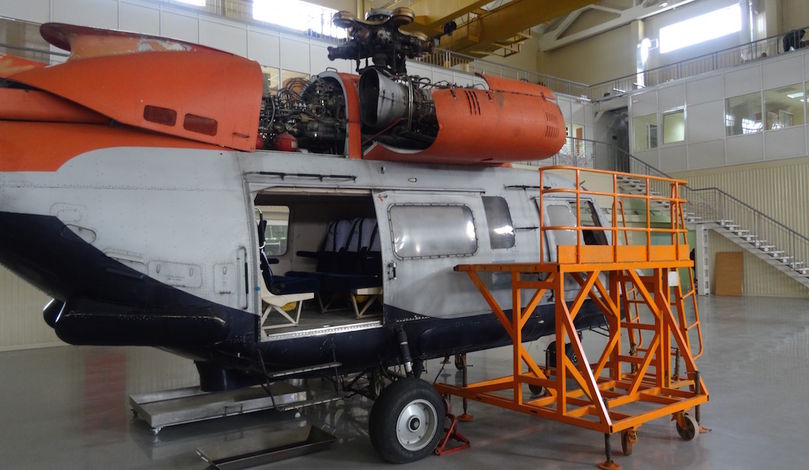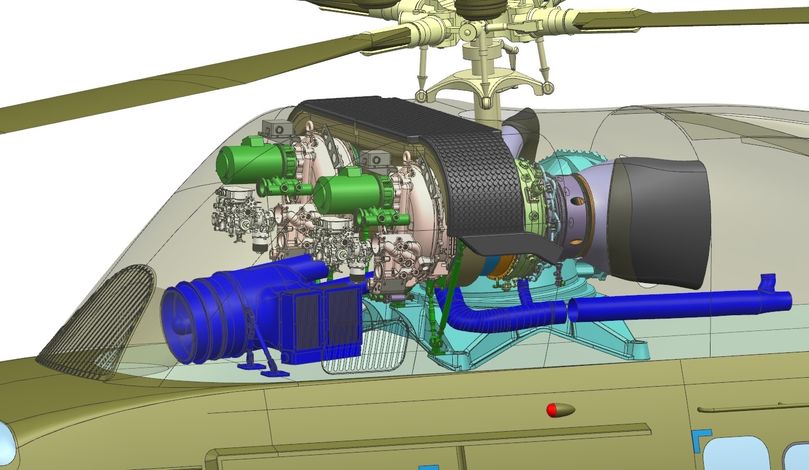Sokół with Motor Sich Engines. Rejuvenation of the Polish Helicopter?
Ukrainian Motor Sich company revealed the details of the project, the aim of which is to modernize the W-3 Sokol/Głuszec helicopters, and retrofit them with new engines. The initiative is being carried out in two areas. One option covers application of the modern MS-500 engine, with simultaneous use of the existing gearbox. The variant which is more ambitious assumes that, more powerful engines are going to be used, along with new gearboxes. Currently, both variants are being worked-on, and the Zaporozhye based company plans to involve the Polish industry in that initiative.
W-3 Sokół has been a successful design, however, no relevant changes have been introduced in its structure, when it comes to the helicopter’s powerplant. Even the latest, electronically controlled Pratt & Whitney PZL-10W engines are a design which is based on almost 40 years old technology. PZL-10W helicopter engine was based on the PZL-10/TWD-10 turbine, being a derivative of the Russian Glushenko TWD-10B engine manufactured in Rzeszow and developed at the Omsk Engine Design Bureau back in 1970. This engine was to be used by An-28 (M28 Bryza) or An-3 aircraft. The production was started in Poland, as the Polish industry received the license to manufacture the An-28 aircraft. Up until now, the engine still remains unchanged. PZL-10W engine is equipped with the FADEC electronic control system, and it has a power output of ca. 900 horsepower.

In case of the W-3 Sokol helicopter, the weight of which is close to 4 tonnes, and maximum take-off weight is defined as 6.5 tonnes, power output offered by two PZL-10W engines does not allow the pilots to use the full potential of the rotorcraft. Bell UH-1N Twin helicopter, with weight of 2.7 tonnes, has a similar power of output, while younger brother of that design, Bell UH-1Y Venom, has been fitted with two engines, with power output of 1500 horsepower each.
Obviously, increase of power of such significance would require the designers to replace the gearbox, so that the power would be transferable to the rotor. Such solution is costly and complicated. Thus, Motor Sich offers two options, when it comes to the powerplant of the helicopters – economic and complex one. The former assumes that a modern, slightly more powerful engine, with significantly better operational properties is applied, while in the latter case, engines that would be much more powerful are installed, and in this case, new engines would be followed by a new main gearbox and modernization of the powertrain. In both variants it is also expected that performance-improving changes would be applied. These changes, keeping the cost relatively reasonable, may have a visible impact on improvement of the helicopter performance data. The changes include use of modern, composite rotor-blades, of the main and the tail rotor. As it has been shown by the US CH-47 Chinook or AH-64 Apache helicopters, such small change has a significant improving impact on the helicopter’s performance, including the speed and payload capabilities.

Within the scope of manufacturing composite rotor elements, avionics, weapons systems of the main gearbox, Motor Sich is willing to cooperate with the Polish companies. The representatives of the Ukrainian manufacturer have already been involved in negotiations within that scope, with the Polish PZL-Świdnik, WSK PZL-Rzeszów or ITWL [Air Force Institute of Technology]. The Ukrainians are willing to modify the helicopters that are already being used, and to sell, within the framework of a Polish-Ukrainian cooperation, the brand-new rotary-winged aircraft – Sokół with the Motor Sich engines. This refers particularly to the export initiatives related to the Asian, African and Middle East markets.
The Ukrainian facility, since several years now, has been making efforts, within the scope of acquiring and modernizing the W-3 Sokół helicopters. Due to the problems, related to procurement of the helicopter directly from the Świdnik-based facility, back in 2014 Motor Sich decided to buy two second-hand examples from South Korea. These examples were used to create detailed digital models of the helicopter, along with its systems and structural elements. Such procedure was required to initiate the design stage related to the engine replacement process, since design and analysis are being conducted in a digital environment. Similarly as in case of the Mi-2 modernization programmes, the related tasks are realized in two phases. The initial phase includes replacement of the engines, with the remaining basic building blocks of the propulsion system remaining as in the original helicopter.
Sokół with Motor Sich MS-500V Engines
It may be stated that applying the MS-500V engine in a helicopter belonging to the W-3 Sokół/Anakonda/Głuszec family, constitutes a modernization, the aim of which is to improve the operational characteristics of these aircraft, and to reduce the costs of operation, thanks to the fact that a “generation gap” would be bridged. The performance of the helicopters would not be significantly changed. As mentioned above, PZL-10W engine is an old design coming from the 1970s, and in comparison with the modern powerplants it is definitely costly and requires a lot of work, when it comes to its maintenance. The MS-500V engine, offered by Motor Sich, has been designed back in 2008, with an extensive use of ceramic elements, mono-crystals and other advanced technologies, which translates into low cost over the operational lifetime, minimum maintenance requirements, and high power and stable parameters, throughout the entire period of operation. MS-500V has been designed to be used with helicopters weighing from 4 to 6.5 tonnes. It was to be applied in case of the Ansat-U and Mi-54 designs.

Motor Sich company also considered using the engine in question within the project of retrofitting the W-3 Sokół helicopters with the new powerplant, at least from mid-2014, when the relevant works on the initiative have been started. For that purpose, the latest variant of the engine, designated as MS-500V-3, has been prepared. In order to replace the PZL-10W engine with the new design, keeping the scope of modification of the aircraft to the bare minimum, MS-500V-3 engine has been fitted with a drive-shaft that extends in its back part. W-3 Sokół helicopter’s gearbox is placed behind its engines. Besides that, numerous other modifications have been implemented, when it comes to placement of the units and power-supply systems.
The power output of those engines is defined as 950 horsepower, 50 HP more than in case of the previous engines which, as the Zaporozhye experts suggest, is placed well within the limits offered by the current gearbox. At the same time, fuel consumption rate for the MS-500V-3 engine is estimated as 260 kg/HP, with a value of 268kg/HP in case of the PZL-10W engine.
The design works related to the process of retrofitting the Sokół helicopter with the MS-500V engines are at the stage of creating the prototype power-supply, mounts and power transmission systems. Works are being realized on the W-3 Sokół example owned by the Motor Sich company. The process will make it possible to verify the design in real, not virtual helicopter, allowing the designers to detect any potential problems that may emerge at this stage. The first Sokół retrofitted with the new engines is going to be used for a ground test programme and system tests. This – as the plans for the next year assume – is going to lead to creation of a flying prototype.
More Power For Sokół

Obviously, the MS-500V engines offer only a minimal improvement within the area of the greatest disadvantage of the W-3 Sokół helicopter, especially pronounced in case of the armed variants, such as the W-3PL Głuszec aircraft. Here, we mean the power to weight ratio. Sokół also features a gearbox which is quite costly to maintain and operate, as well as the main rotor, the blades of which show an insufficient level of flexibility. The above issues lead to a lack of option of fully using the combat and transport capabilities offered by Głuszec, which is an armed variant of the Sokół helicopter.
Back in 2005, PZL-Świdnik began the analytic and research works, the aim of which was to get rid of the above problems. As a result of the market analyses, user feedback, production and operational experience, and the current and expected trends, related to development of the helicopters in general, assumptions have been created for a “W-3 Sokoł 2” rotorctraft. Such proposal has been demonstrated at the Kielce MSPO Salon, back in 2009. The design assumed that the powerplant is going to be replaced with a more powerful one, featuring LHTEC T-800 engines, with a power output of ca. 1500 HP each, and the helicopter was also to receive a new, five-bladed main rotor. The whole modernization was to be carried out with the use of the existing components of the W-3 helicopter, to the highest possible extent.
A similar idea is proposed by the Motor Sich company, which is willing to retrofit the W-3 Sokół/Głuszec helicopters, with the use of the MS-14W engines, offering 1600 HP of power output each. Along with a new set of engines, applying a modernized gearbox and power transmission systems, and a new rotor, the parameters of which would accommodate the power output which would be twice as high as in case of the original design, would be required. MS-14 engines, due to their size and layout, would be installed not in front of the reduction gearbox, as they are to be placed on both sides of that unit. The power is going to be provided to a brand-new main rotor, equipped with five, modern blades, made out of composites. Tail rotor and its shaft, along with a number of other elements, are also going to be modified. However, the basic aircraft structure is going to be retained, which makes the implemented modifications cost-effective, both in case of the new helicopters, as well as in case of the airframes to be modified that are being already operated. Thanks to the aforementioned changes, the helicopter’s flight performance characteristics would be vastly improved, including the climb rate, and the flight profile in hot climate conditions and at high altitudes.
If one replaced the W-3 helicopter’s powerplant with a more powerful engine, its performance, load capacity and operating weight are all going to be significantly increased. If, now, Sokoł helicopter fitted with the old engine, is capable of carrying payload of 1000 - 1200 kilograms, with the new powerplant it would carry two tonnes of load. This increases the profitability of operation and expands the operational envelope. This is why we reached out to PZL Świdnik, proposing that offer.
The project, in the light of the increased costs and complexity, enters the initial design phase at the moment. The works are being carried out, the aim of which is to design proper systems and develop the data pertaining the requirements related to the individual elements, such as the main gearbox. Within the scope of the elements such as the rotor blades, reduction gearbox and the armament, Motor Sich is interested in cooperation with the Polish companies. An offer has been created to establish an assembly facility, and an engine factory – in the future – in Poland, dealing with the engines that would be used in case of the modified W-3 Sokół helicopters. Currently these initiatives depend on the future developments of the cooperation dialogue between Motor Sich and PZL Świdnik. This is, without any doubts, a chance for the Sokół helicopter to be rejuvenated, while the Polish industry would develop, and export its products.







